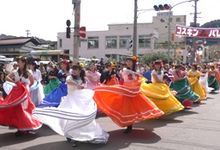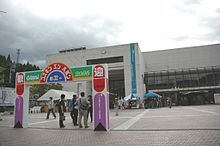- Cosquín en Japón
-
 Cosquín en Japón 2006
Cosquín en Japón 2006
Cosquín en Japón is a three-day Andean music festival held annually in Kawamata, Fukushima, Japan.[1]
In 1955, Yasumitsu Naganuma (長沼康光), a resident of Kawamata and Andean music enthusiast, formed Norte Japón, otherwise known as the Northern Japan South American Music Alliance (北日本中南米音楽連盟). In 1975 the Alliance held the first Cosquín en Japón event at the Kawamata Welfare Center (川俣町福祉センター), with 13 amateur groups performing.
In 1981, the festival was moved to the Kawamata Central Public Hall, due to an increase in the number of performing groups, and in 2002 was expanded to become a three-day festival. Top performers and professionals from Japan and overseas now attend the festival, which is currently the largest Andean music festival in the country. In 2006, 161 groups performed, making it the largest Cosquín as of yet.
The name "Cosquín en Japón" is derived from the Cosquín Festival held in Cosquín, Argentina.
International exchange
Increased awareness of Cosquín en Japón has deepened international ties with Argentina and the city of Cosquín. During the Japanese hosting of the 2002 FIFA World Cup, residents of Kawamata, at the urging of Argentina, formed a Japanese-style cheer club to cheer on the Argentinian team.[2]
The Argentinian ambassador to Japan and the mayor of Cosquín have paid visits to Kawamata. Residents of Kawamata, including the mayor, have also visited Cosquín. Since 1999, Cosquín en Japón has held an annual contest to send representatives of Japan to the original Cosquín Festival in Argentina.
Awards
- 1993 Suntory Regional Culture Award (サントリー地域文化賞)
- 2001 Yasumitsu Naganuma designated an Outstanding Contributor to Regional Culture (地域文化功労者) by the Agency for Cultural Affairs (文化庁)
- 2002 The Minister for Internal Affairs and Communications Regional Development Award (地域づくり総務大臣表彰) awarded to Kawamata
References
- ^ "コスキン・エン・ハポン [Cosquín en Japón]" (in Japanese). Kawamata-machi. http://www.town.kawamata.fukushima.jp/cosquin/index.html. Retrieved 2010-10-22.
- ^ "アルゼンチンまず一勝 各地で応援イベント [Argentinian Cheering Events]" (in Japanese). Fukushima Chuo TV News. 2002-06-02. http://www.fct.co.jp/news/200099.html?start=1012. Retrieved 2010-10-26.
Categories:- Argentine music
- Andean music
- Music festivals in Japan
- Fukushima Prefecture
- Recurring events established in 1975
Wikimedia Foundation. 2010.


